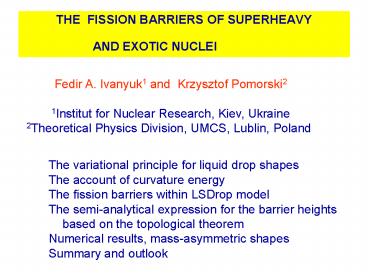THE FISSION BARRIERS OF SUPERHEAVY AND EXOTIC NUCLEI - PowerPoint PPT Presentation
1 / 18
Title:
THE FISSION BARRIERS OF SUPERHEAVY AND EXOTIC NUCLEI
Description:
The variational principle for liquid drop shapes. The account of curvature energy ... drop fission barriers were calculated for isotopic chains in the range 35 Z ... – PowerPoint PPT presentation
Number of Views:55
Avg rating:3.0/5.0
Title: THE FISSION BARRIERS OF SUPERHEAVY AND EXOTIC NUCLEI
1
THE FISSION BARRIERS OF SUPERHEAVYAND EXOTIC
NUCLEI
Fedir A. Ivanyuk1 and Krzysztof
Pomorski2 1Institut for Nuclear Research, Kiev,
Ukraine 2Theoretical Physics Division, UMCS,
Lublin, Poland
- The variational principle for liquid drop shapes
- The account of curvature energy
- The fission barriers within LSDrop model
- The semi-analytical expression for the barrier
heights based on the topological theorem - Numerical results, mass-asymmetric shapes
- Summary and outlook
2
- For Emicr see P. Moeller, J. R. Nix,
- W. D. Myers and W. J. Swiatecki,
- At. Data and Nucl. Data Tables,
- 59, 249 (1995).
- The rms-deviation is 1.113 MeV for known nuclei
withZgt70
3
V.M.Strutinsky et al, Nucl. Phys. 46, 659 (1963)
4
Optimal shapes
5
Deformation energy
6
R.W.Hasse, W.D.Myers, Geometrical Relationships
of Macroscopic Nuclear Physics
7
Modified Funny Hills shape parametrization
- deviation lt 150 keV
8
Surface curvature energy
- Leptodermous expansion
- ETF Evol Esurf Ecurv EGcurv
9
The LSD barrier heights
K.Pomorski and J. Dudek, Phys. Rev. C 67, 044316
(2003)
F.A.Ivanyuk and K.Pomorski, Phys Rev. C
79, 054327 (2009)
The rms dev.for 35ltZlt 105, 0ltIlt 0.3 is 150 keV
10
The barrier heights, topological theorem
W. D.Myers and W. J. Swiatecki, Nucl. Phys.
A601, 141 (1996) the barrier will be determined
by a path that avoids positive shell effects and
has no use for negative shell effects. Hence the
saddle point energy will be close to what it
would have been in the absence of shell effects,
i.e., close to the value given by the
macroscopic theory!
- For Emicr see P. Moeller, J. R. Nix, W. D. Myers
and W. J. Swiatecki, At. Data and Nucl. Data
Tables, 59, 249 (1995).
11
Barriers of light nuclei
75Br35 , 90Mo42 , 94 Mo42 , 98Mo42
12
Mass asymmetry
13
The temperature dependence of the LSD-barriers
- B. Nerlo-Pomorska, K. Pomorski and J. Bartel,
- Phys. Rev. C 74, 034327 (2006)
14
Summary
- The optimal shapes of fissioning nuclei are
studied within the Lublin-Strasbourg drop model - The liquid drop fission barriers were calculated
for isotopic chains in the range 35lt Z lt 110 and
a simple approximation for the liquid drop
fission barriers heights containing only Z and
(N-Z)/A is obtained. - The topological theorem by Myers and Swiatecki
was used to express the fission barrier height as
the sum of the macroscopic barrier height and the
ground-state shell correction. This provides a
very simple method to calculate fission barrier
heights. In addition to the ground-state shell - correction, which should be taken from the
tables, one only has to calculate simple
analytical estimate for the liquid drop part of
the barrier height. - The rms deviation of calculated versus
experimental values of fission-barrier heights
for known nuclei with Z lt 70 is 1.113 MeV, a
value that is comparable with the experimental
uncertainties.
15
- Dear colleagues,
- This is the first circular of the 3-rd
International Conference on Current Problems - in Nuclear Physics and Atomic Energy
(NPAE-Kyiv2010), which will be held from - June 7 to June 12, 2010 in Kyiv, Ukraine.
- The NPAE-Kyiv2010 conference will cover the
following topics - Collective processes in atomic nuclei
- Nuclear reactions
- Nuclear structure and decay processes
- Rare nuclear processes
- Neutron and reactor physics, nuclear data
- Problems of atomic energy
- Applied nuclear physics in medicine and industry
- Experimental facilities and detection techniques
16
Mass-asymmetric shapes
17
Mass asymmetric shapes, x 0.75
18
K.T.R.Davies and A.J.Sierk, Phys.Rev.C 31 (1985)
915































